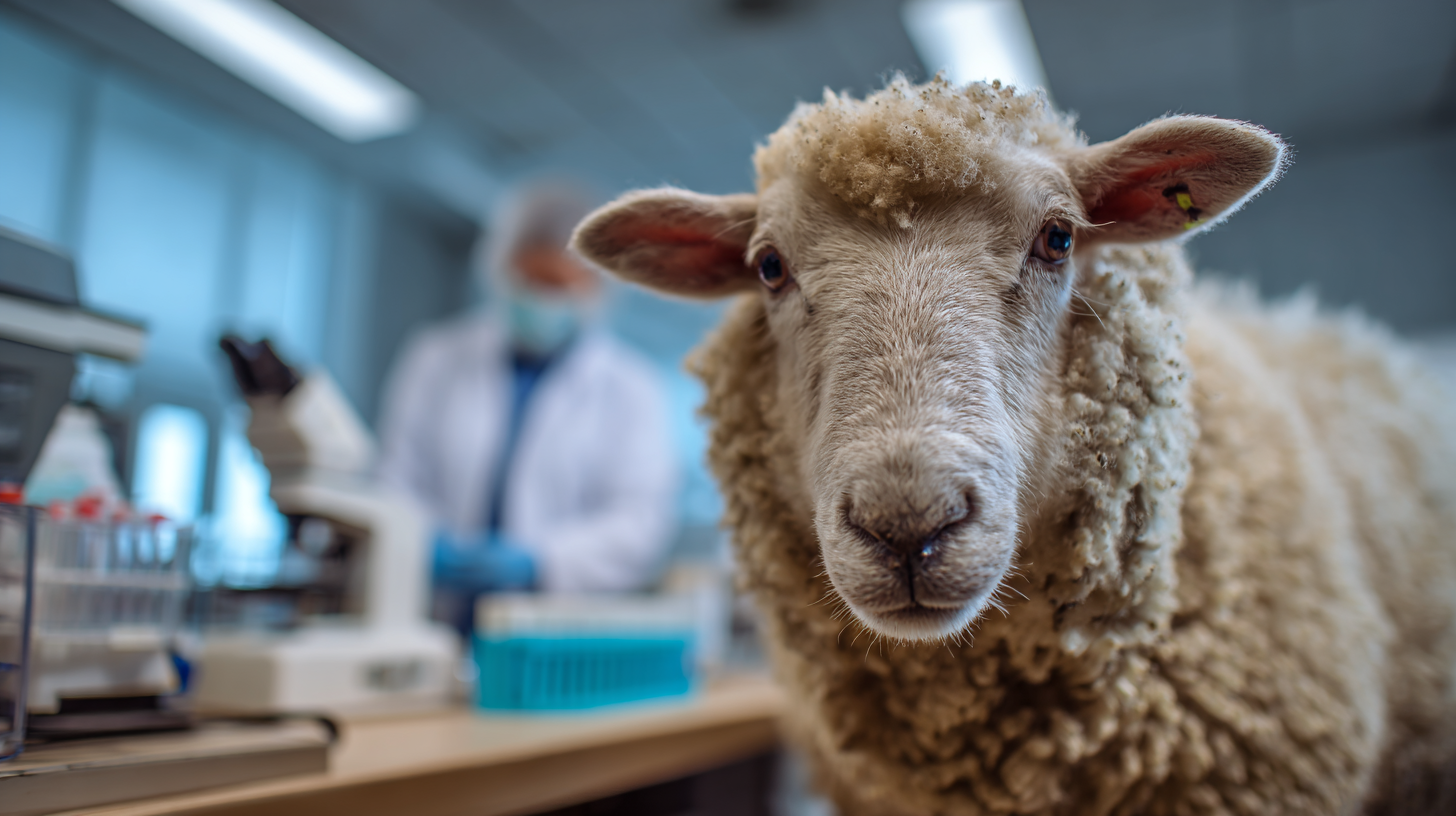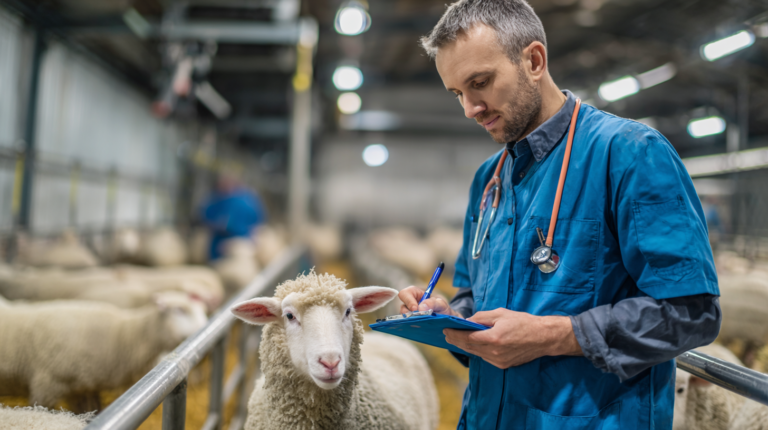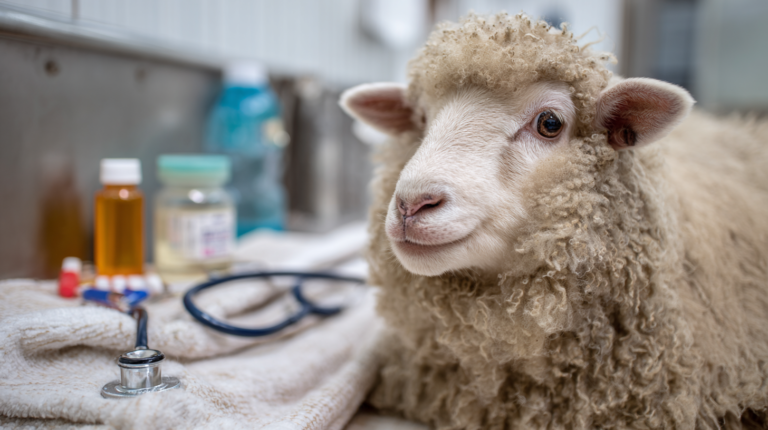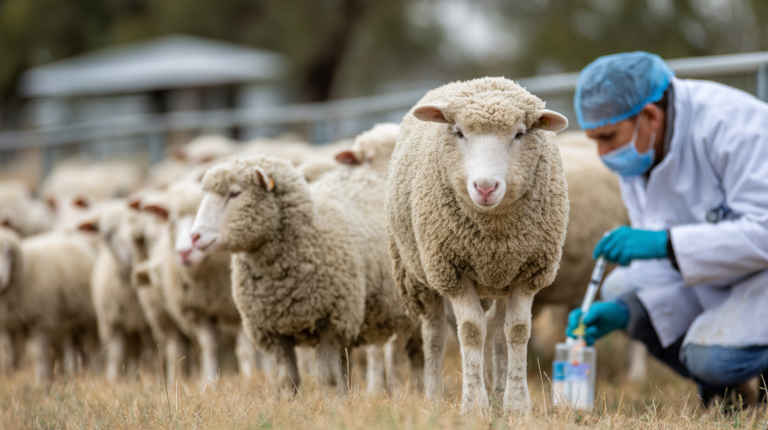Discover the 5 early signs of Johne’s Disease in sheep and learn effective management strategies. Expert veterinary advice for sheep owners and livestock managers.
Table of Contents
When Sarah noticed her prize ewe losing weight despite maintaining a healthy appetite, she initially attributed it to the stress of lambing season. However, as weeks passed and the condition worsened, she discovered her flock was facing one of the most challenging bacterial infections in sheep farming: Johne’s Disease. This insidious condition, caused by Mycobacterium avium subspecies paratuberculosis (MAP), affects millions of sheep worldwide and poses significant economic and welfare challenges for livestock owners.
Johne’s Disease in sheep represents one of the most persistent and economically devastating infections in the livestock industry. Unlike many bacterial infections that respond quickly to treatment, this chronic inflammatory bowel disease progresses slowly over months or years, making early detection crucial for effective management. Understanding the early warning signs and implementing comprehensive management strategies can mean the difference between containing the disease and facing widespread flock losses.
The complexity of Johne’s Disease lies not only in its subtle initial presentation but also in its ability to remain dormant for extended periods before manifesting clinical symptoms. This characteristic makes it particularly challenging for sheep owners to identify and address before significant damage occurs to both individual animals and the broader flock. The disease’s impact extends beyond immediate animal welfare concerns, affecting milk production in dairy sheep, reproductive performance, and overall flock productivity.
Understanding Johne’s Disease:
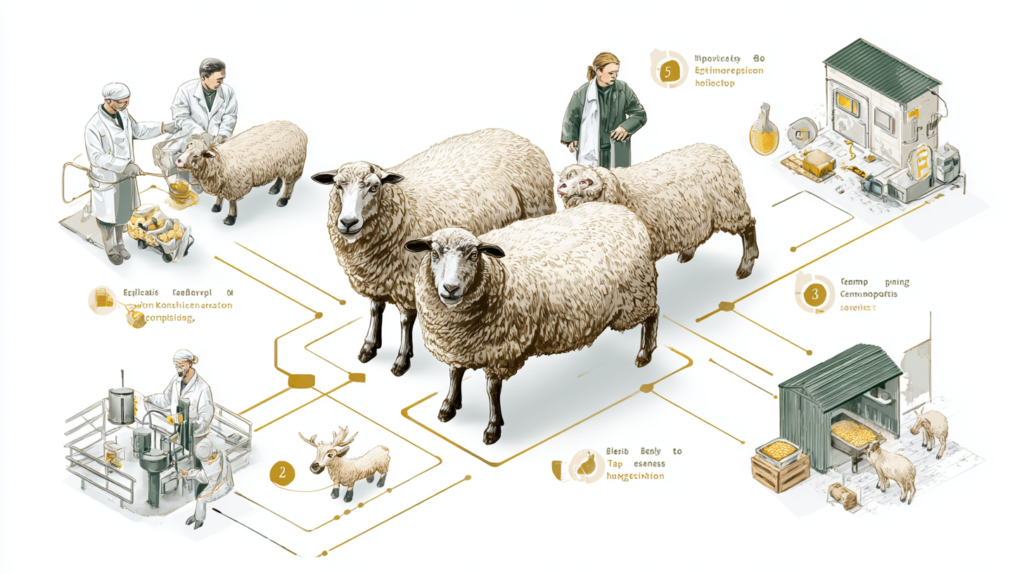
Johne’s Disease, also known as paratuberculosis, stands as one of the most economically significant chronic infections affecting sheep globally. This bacterial infection specifically targets the intestinal tract, causing a progressive inflammatory response that ultimately leads to severe malabsorption and wasting. The causative agent, Mycobacterium avium subspecies paratuberculosis, demonstrates remarkable persistence in the environment and resistance to standard disinfection procedures.
The pathophysiology of Johne’s Disease involves the gradual thickening of the intestinal wall, particularly in the terminal ileum and cecum. As the bacteria multiply within macrophages, they trigger an inflammatory cascade that progressively impairs the sheep’s ability to absorb nutrients effectively. This malabsorption occurs long before visible clinical signs appear, making early detection challenging but absolutely critical for effective management.
Environmental persistence represents one of the most concerning aspects of this disease. The bacteria can survive in soil, water, and organic matter for extended periods, with some studies indicating viability for up to 55 weeks in favorable conditions. This persistence means that once a property becomes contaminated, eliminating the organism requires comprehensive, long-term management strategies that address both infected animals and environmental reservoirs.
The economic impact of Johne’s Disease extends far beyond individual animal losses. Infected sheep experience reduced milk production, poor reproductive performance, and increased susceptibility to other diseases. Additionally, the chronic nature of the infection means that affected animals may appear healthy for extended periods while continuously shedding bacteria and infecting other flock members. This silent spread can result in significant portions of a flock becoming infected before clinical signs become apparent.
Recent research has highlighted the zoonotic potential of Johne’s Disease, with some studies suggesting possible links to Crohn’s disease in humans. While the evidence remains inconclusive, this potential connection has increased awareness about the importance of effective disease management and has led to enhanced surveillance programs in many regions.
| Early Sign | Description | Typical Timeline | Severity Level |
|---|---|---|---|
| Gradual Weight Loss | Progressive weight reduction despite maintained appetite and normal feed intake | 6-12 months after infection | Medium |
| Chronic Diarrhea | Persistent loose stools and changes in fecal consistency, often intermittent | 1-2 years post-infection | High |
| Decreased Milk Production | Reduced milk yield and poor reproductive performance in breeding ewes | During lactation periods | Medium |
| Behavioral Changes | Reduced activity levels, lethargy, and separation from the flock | Variable, 1-3 years | Low-Medium |
| Poor Body Condition | Rough hair coat, visible ribs, and overall deteriorating physical appearance | Advanced stages (2-5 years) | High |
The Five Critical Early Signs of Johne’s Disease in Sheep
1. Gradual Weight Loss Despite Maintained Appetite
The most characteristic early sign of Johne’s Disease in sheep manifests as progressive weight loss that occurs despite the animal maintaining normal or even increased appetite. This seemingly paradoxical presentation often confuses sheep owners, who may initially attribute the condition to parasites or inadequate nutrition. However, the weight loss associated with Johne’s Disease follows a distinctive pattern that experienced observers can learn to recognize.
The weight loss typically begins subtly, with affected sheep showing a gradual loss of body condition over several weeks or months. Unlike weight loss caused by nutritional deficiencies or heavy parasite loads, animals with Johne’s Disease often continue to show interest in food and may even appear to consume more feed than usual. This increased appetite occurs as the body attempts to compensate for the poor nutrient absorption caused by the inflamed intestinal lining.
Body condition scoring becomes an invaluable tool for detecting this early sign. Sheep with developing Johne’s Disease gradually lose muscle mass and fat reserves, particularly noticeable along the backbone, over the ribs, and around the tail head. The progression typically follows a predictable pattern, with animals first losing subcutaneous fat, followed by muscle wasting as the disease advances.
Visual assessment techniques can help identify affected animals before severe weight loss occurs. Observing sheep from behind reveals hollowing around the tail head and loss of muscling in the hindquarters. When viewed from the side, the spine becomes more prominent, and the ribs may become visible. These changes occur gradually, making regular monitoring essential for early detection.
Professional body condition scoring systems provide objective measurements that can track changes over time. Regular scoring at monthly intervals allows for early identification of animals showing declining condition before severe weight loss becomes apparent. This proactive approach enables earlier intervention and helps prevent the spread of infection to other flock members.
2. Chronic Diarrhea and Changes in Fecal Consistency
Diarrhea represents one of the most recognizable clinical signs of advanced Johne’s Disease, but changes in fecal consistency often begin much earlier in the disease process. These early changes may be subtle and intermittent, making them easy to overlook without careful observation. Understanding the progression of fecal changes helps sheep owners identify potentially affected animals before severe diarrhea develops.
The initial stages of Johne’s Disease may present with soft, poorly formed feces that lacks the normal pelleted appearance typical of healthy sheep. These changes often occur intermittently, with periods of normal fecal consistency interspersed with softer stools. The intermittent nature of these early changes means that single observations may not reveal the problem, emphasizing the importance of regular monitoring.
As the disease progresses, fecal consistency becomes increasingly abnormal. The characteristic “pipe-stem” diarrhea associated with advanced Johne’s Disease develops gradually, beginning with increasingly soft stools that eventually become liquid. This progression typically occurs over months, providing multiple opportunities for early detection through careful observation.
Environmental factors can influence the presentation of fecal changes in sheep with Johne’s Disease. Stress, dietary changes, or concurrent infections may exacerbate diarrhea in affected animals, while favorable conditions might temporarily mask the severity of fecal abnormalities. This variability underscores the importance of consistent, long-term monitoring rather than relying on single observations.
The consistency, color, and odor of feces provide additional diagnostic clues. Sheep with Johne’s Disease often produce feces with a distinctive odor and may show changes in color, ranging from normal brown to yellowish or greenish hues. These changes reflect the inflammatory processes occurring within the intestinal tract and the malabsorption of nutrients.
3. Decreased Milk Production and Reproductive Performance
Reproductive performance and milk production serve as sensitive indicators of overall health status in sheep, making them valuable early warning signs for Johne’s Disease. Infected ewes often experience subtle but measurable decreases in milk yield, even when other clinical signs remain minimal. This reduction in milk production can significantly impact lamb growth rates and overall flock productivity.
The relationship between Johne’s Disease and reproductive performance extends beyond simple milk production. Infected ewes may experience reduced conception rates, increased embryonic loss, and higher rates of pregnancy complications. These reproductive impacts often manifest before obvious clinical signs of disease become apparent, making reproductive monitoring an important component of early detection programs.
Lamb performance provides another early indicator of maternal infection. Lambs nursing from infected ewes may show reduced growth rates, even when the ewe appears clinically normal. This reduced performance occurs due to decreased milk quality and quantity, as well as potential direct infection of lambs through contaminated milk. Monitoring lamb growth rates can therefore serve as an indirect method for identifying infected ewes.
The immune system’s response to chronic infection affects reproductive hormone production and function. Infected ewes may experience disrupted estrous cycles, reduced fertility, and increased susceptibility to other reproductive diseases. These changes often occur gradually and may be attributed to other factors unless systematic monitoring reveals patterns consistent with Johne’s Disease.
Milk quality testing can provide additional insights into disease status. Infected ewes may show changes in milk composition, including alterations in protein content, fat percentages, and somatic cell counts. While these changes are not specific to Johne’s Disease, they can support diagnostic efforts when combined with other clinical observations.
4. Behavioral Changes and Reduced Activity Levels
Behavioral modifications often provide the earliest indicators of Johne’s Disease in sheep, frequently appearing before obvious physical signs develop. These changes may be subtle and require careful observation to detect, but they offer valuable opportunities for early intervention. Understanding normal sheep behavior patterns becomes essential for recognizing these early alterations.
Affected sheep often display reduced social interaction and may separate themselves from the main flock. This isolation behavior may manifest as spending more time alone, reduced participation in group activities, or seeking sheltered areas away from other animals. The gradual nature of these changes means they may go unnoticed unless observers specifically monitor for behavioral modifications.
Activity levels typically decrease as the disease progresses, but these changes often begin subtly. Infected sheep may show reduced enthusiasm for feed, less interest in exploration, and decreased responsiveness to environmental stimuli. These behavioral changes reflect the animal’s declining energy levels and overall well-being as the disease affects nutrient absorption and general health.
Feed consumption patterns may change before obvious appetite loss occurs. Affected sheep might take longer to consume their daily ration, show less competitive behavior at feeding time, or demonstrate reduced interest in preferred feeds. These changes can be particularly noticeable in intensive management systems where individual animal monitoring is more feasible.
Response to handling and routine procedures often changes in sheep with developing Johne’s Disease. Affected animals may show less resistance to restraint, reduced stress responses, or unusual calmness during procedures. While these changes might initially seem positive, they actually reflect the animal’s reduced energy levels and compromised physiological state.
5. Rough Hair Coat and Poor Body Condition
The condition of a sheep’s fleece and overall appearance provides valuable insights into internal health status. Sheep with developing Johne’s Disease often exhibit changes in wool quality and general appearance that occur before other clinical signs become obvious. These changes reflect the systemic effects of chronic infection and malnutrition on the animal’s ability to maintain normal physiological functions.
Fleece quality deterioration typically manifests as reduced luster, increased brittleness, and poor staple formation. The wool may appear dull and lifeless compared to healthy flock mates, and individual fibers may break more easily during handling. These changes occur gradually and may be more noticeable during shearing or routine fleece inspection.
Skin condition often deteriorates in conjunction with fleece quality changes. Affected sheep may develop dry, flaky skin or show increased susceptibility to external parasites. The skin may appear less elastic and recover more slowly from pinch tests, indicating developing dehydration and poor nutritional status.
Body conformation changes accompany the more obvious weight loss associated with Johne’s Disease. Affected sheep may develop a “bottle-jaw” appearance due to fluid accumulation, show increased prominence of bony structures, and display muscle wasting in characteristic patterns. These changes progress gradually and may be more noticeable to experienced observers familiar with normal sheep conformation.
The overall appearance of affected sheep often includes a general lack of vigor and alertness. Eyes may appear less bright, posture may seem less erect, and the animal’s general demeanor may suggest chronic unwellness. These subtle changes in appearance often precede more obvious clinical signs and can alert observant caregivers to potential problems.
Diagnostic Approaches and Testing Methods
Accurate diagnosis of Johne’s Disease requires a comprehensive approach that combines clinical observation, laboratory testing, and careful interpretation of results. The chronic nature of the disease and its variable presentation mean that no single test provides definitive answers in all cases. Instead, veterinarians rely on a combination of diagnostic tools to establish accurate diagnoses and develop appropriate management strategies.
Fecal culture remains the gold standard for diagnosing Johne’s Disease, despite its limitations. This method involves growing the bacteria from fecal samples under specific laboratory conditions, a process that can take 12-16 weeks to complete. While culture provides definitive proof of infection, its lengthy turnaround time and the intermittent shedding patterns of infected animals mean that negative results don’t necessarily rule out infection.
Polymerase chain reaction (PCR) testing offers a more rapid alternative to traditional culture methods. PCR can detect bacterial DNA in fecal samples within days rather than months, making it valuable for routine screening programs. However, PCR results must be interpreted carefully, as they may detect dead bacteria or environmental contamination, potentially leading to false-positive results.
Serological testing measures the immune response to Johne’s Disease infection rather than detecting the bacteria directly. ELISA (enzyme-linked immunosorbent assay) tests can identify antibodies against MAP in blood or milk samples, providing a convenient screening method for large numbers of animals. However, serological tests may not detect early infections, and some animals never develop detectable antibody responses.
Histopathological examination of intestinal tissues provides definitive diagnosis in many cases, though this approach requires post-mortem examination or surgical biopsy. Characteristic inflammatory changes in the intestinal wall, combined with the presence of acid-fast bacteria, confirm the diagnosis. This method proves particularly valuable for confirming suspected cases and understanding disease progression.
The integration of multiple diagnostic approaches provides the most reliable assessment of flock infection status. Combining clinical observation with laboratory testing allows for more accurate identification of infected animals and better understanding of disease distribution within the flock. This comprehensive approach forms the foundation for effective management strategies.
Management Strategies and Prevention Protocols
| Strategy Category | Specific Action | Implementation Details | Priority Level |
|---|---|---|---|
| Biosecurity | Quarantine New Arrivals | Separate new sheep for 30-60 days with testing before flock integration | Critical |
| Testing Protocol | Regular Flock Screening | Annual testing using fecal culture and PCR methods for early detection | Critical |
| Animal Management | Cull Positive Animals | Remove confirmed infected sheep immediately to prevent transmission | Critical |
| Feed Management | Avoid Contaminated Sources | Use clean feed and water sources, avoid pooled water areas | Important |
| Equipment Hygiene | Disinfection Protocols | Regular cleaning and disinfection of shared equipment and facilities | Important |
| Record Keeping | Health Documentation | Maintain detailed records of testing results and animal health status | Recommended |
| Visitor Control | Limit Farm Access | Control visitor access and implement hygiene protocols for all visitors | Important |
Immediate Response Measures
When Johne’s Disease is suspected or confirmed in a sheep flock, immediate action is essential to prevent further spread and minimize economic losses. The first priority involves isolating suspected animals from the main flock to reduce transmission risk. This isolation should be maintained until diagnostic testing confirms or rules out infection, and infected animals should remain separated indefinitely.
Comprehensive testing of the entire flock becomes necessary once infection is confirmed. This testing should include multiple diagnostic methods to account for the variable shedding patterns and immune responses associated with Johne’s Disease. Sequential testing over several months may be required to identify all infected animals accurately.
Environmental management plays a crucial role in immediate response efforts. Contaminated areas should be identified and subjected to appropriate disinfection protocols. While MAP shows remarkable environmental persistence, certain disinfectants and environmental modifications can reduce bacterial loads and transmission risk.
Record-keeping becomes essential during disease outbreaks. Detailed documentation of animal movements, test results, and management interventions provides valuable information for tracking disease spread and evaluating control measures. These records also support regulatory compliance and insurance claims when applicable.
Veterinary consultation should be obtained immediately upon suspecting Johne’s Disease. Veterinarians can provide guidance on diagnostic testing, regulatory requirements, and appropriate management strategies. Their expertise proves invaluable in developing comprehensive control programs tailored to specific flock circumstances.
Long-term Flock Management
Successful long-term management of Johne’s Disease requires a comprehensive approach that addresses both infected animals and environmental contamination. Culling infected animals represents the most effective method for reducing bacterial shedding and transmission risk. However, economic considerations may influence culling decisions, particularly in valuable breeding animals.
Genetic selection programs can contribute to long-term disease control by identifying animals with natural resistance to Johne’s Disease. While genetic resistance is not absolute, some sheep lines show reduced susceptibility to infection or delayed disease progression. Incorporating resistance traits into breeding programs can provide long-term benefits for flock health.
Nutritional management plays a supporting role in disease control by maintaining optimal immune function in uninfected animals. Adequate nutrition cannot prevent infection, but it may help delay disease progression and reduce susceptibility to secondary infections. Specific nutritional interventions, such as trace mineral supplementation, may provide additional benefits.
Environmental modifications can reduce transmission risk and improve overall flock health. These modifications include improved drainage, reduced crowding, and enhanced sanitation practices. While these measures cannot eliminate infection risk entirely, they can significantly reduce bacterial loads and transmission opportunities.
Monitoring programs should be implemented to track disease progression and evaluate control measures. Regular testing of remaining animals, careful observation for clinical signs, and periodic reassessment of management strategies help ensure continued effectiveness of control efforts.
Biosecurity Implementation
Effective biosecurity measures form the foundation of Johne’s Disease prevention and control. These measures must address both the introduction of infected animals and the spread of contamination through various vectors. Comprehensive biosecurity programs require careful planning and consistent implementation to achieve maximum effectiveness.
Quarantine procedures for incoming animals represent the first line of defense against disease introduction. New arrivals should be isolated for a minimum of 30 days and subjected to appropriate testing before joining the main flock. This quarantine period allows for observation of clinical signs and completion of diagnostic testing.
Visitor protocols should be established to minimize the risk of mechanical transmission. Equipment, vehicles, and personnel can carry MAP bacteria between properties, making decontamination procedures essential. Dedicated clothing and footwear for visitors, along with appropriate disinfection protocols, help reduce transmission risk.
Feed and water management requires special attention in infected flocks. Contaminated feed and water sources can serve as significant transmission routes, particularly for young animals. Implementing measures to prevent fecal contamination of feed and water supplies helps reduce infection risk.
Wildlife management may be necessary in some situations, as certain wildlife species can carry MAP bacteria. While the significance of wildlife in disease transmission remains debated, controlling access to feed and water sources can reduce potential contamination from this source.
Economic Impact and Industry Considerations
| Disease Phase | Timeline from Infection | Diagnostic Method | Test Accuracy | Treatment Options |
|---|---|---|---|---|
| Early Stage | 0-6 months | Limited Detection | Variable | Prevention focus, no effective treatment |
| Subclinical | 6 months – 2 years | PCR Testing | Medium (60-80%) | Management protocols, isolation measures |
| Clinical Signs | 2-3 years | Fecal Culture | High (85-95%) | Culling recommended, supportive care only |
| Progressive | 3-4 years | Serological Tests | High (80-90%) | Immediate culling, biosecurity enhancement |
| Advanced Clinical | 4-5+ years | Multiple Methods | Very High (95%+) | Palliative care, humane euthanasia consideration |
| Terminal Stage | 5+ years | Clinical Diagnosis | Definitive | Humane euthanasia, environmental decontamination |
The economic implications of Johne’s Disease extend far beyond the immediate costs of animal losses and veterinary interventions. Understanding these broader impacts helps sheep owners and industry stakeholders appreciate the importance of comprehensive disease management programs. The hidden costs of chronic infection often exceed the obvious expenses associated with clinical disease.
Production losses represent the most significant economic impact of Johne’s Disease. Infected sheep experience reduced milk production, poor reproductive performance, and decreased wool quality long before obvious clinical signs appear. These subclinical effects can reduce flock productivity by 10-25% even when clinical disease rates remain low.
Market access restrictions increasingly affect farms with known Johne’s Disease problems. Many breeding programs and export markets require health certification that may be compromised by disease presence. These restrictions can limit marketing opportunities and reduce the value of breeding stock significantly.
Insurance and liability considerations have become more prominent as awareness of Johne’s Disease increases. Some insurance policies may exclude coverage for losses related to endemic diseases, while liability concerns may arise from selling infected animals. These factors add complexity to risk management decisions.
The cost of diagnostic testing and management interventions must be weighed against potential benefits. While comprehensive testing programs require significant investment, early detection and appropriate management can prevent much larger losses from widespread infection. Cost-benefit analyses help guide decision-making in control programs.
Research and development investments in Johne’s Disease control continue to expand, driven by industry needs and regulatory pressures. New diagnostic methods, management strategies, and potential treatments offer hope for improved control in the future. Staying informed about these developments helps producers make informed management decisions.
Regional Variations and Regulatory Considerations
Johne’s Disease prevalence and management approaches vary significantly between regions, influenced by factors including climate, management systems, and regulatory frameworks. Understanding these regional differences helps sheep owners develop appropriate management strategies and comply with relevant regulations.
Prevalence studies from different regions reveal significant variation in infection rates. Some areas report flock-level prevalence rates exceeding 50%, while others maintain much lower infection levels. These differences reflect various factors including management practices, genetic susceptibility, and environmental conditions.
Regulatory approaches to Johne’s Disease control vary considerably between jurisdictions. Some regions have implemented mandatory testing and reporting requirements, while others rely on voluntary programs. Understanding local regulations ensures compliance and helps producers access available support programs.
Climate and environmental factors influence disease transmission and management strategies. Regions with wet, cool climates may experience higher transmission rates due to improved bacterial survival in the environment. These factors must be considered when developing management programs.
Export and interstate movement requirements often include provisions related to Johne’s Disease. Sheep destined for breeding purposes may require specific health certifications, while commercial animals may face fewer restrictions. Understanding these requirements helps prevent costly delays and rejections.
Support programs and resources vary significantly between regions. Some areas offer cost-sharing for testing programs, educational resources, and technical assistance. Producers should investigate available programs to maximize the effectiveness of their disease management efforts.
Future Directions and Research Developments
The field of Johne’s Disease research continues to evolve, with promising developments in diagnosis, treatment, and prevention. Staying informed about these advances helps producers make informed decisions about disease management and provides hope for improved control in the future.
Diagnostic technology improvements focus on developing faster, more accurate, and more cost-effective testing methods. New PCR techniques, improved serological assays, and novel biomarkers offer potential for earlier detection and more reliable results. These advances could revolutionize disease management approaches.
Vaccine development remains an active area of research, though progress has been challenging due to the complex nature of immune responses to MAP. Several experimental vaccines show promise in reducing disease severity and transmission, though none are currently available for commercial use.
Genetic research continues to identify markers associated with disease resistance and susceptibility. This work may lead to more effective breeding programs and help explain the variable responses observed in different animals and populations.
Environmental management research focuses on developing more effective methods for reducing bacterial loads and transmission risk. New disinfection techniques, pasture management strategies, and facility design concepts offer potential for improved control.
Treatment research explores potential therapeutic interventions for infected animals. While no effective treatments currently exist, experimental approaches including immunomodulatory drugs and targeted antimicrobial therapy show promise for future development.
Frequently Asked Questions
Find answers to the most common questions about Johne’s Disease in sheep, from early symptoms to prevention strategies.
Johne’s Disease has a long incubation period, typically 2-5 years from initial infection to obvious clinical signs. However, subtle changes like gradual weight loss and reduced productivity may appear 6-12 months after infection. This lengthy incubation period makes early detection challenging but emphasizes the importance of regular monitoring and testing programs.
While MAP bacteria have been found in some human tissues and milk products, definitive evidence of transmission from sheep to humans remains limited. However, proper hygiene practices when handling infected animals are recommended. The potential zoonotic risk remains an area of ongoing research, and producers should follow standard biosecurity protocols when dealing with infected animals.
Currently, no effective treatment exists for Johne’s Disease in sheep. Antibiotics may temporarily reduce bacterial shedding but cannot eliminate infection. Management focuses on preventing transmission through quarantine, culling infected animals, and implementing comprehensive biosecurity measures. Research continues into potential therapeutic approaches, but prevention remains the most effective strategy.
Test accuracy varies depending on the method used and stage of infection. Fecal culture is highly specific but may miss early infections due to intermittent shedding. PCR testing offers faster results but may detect dead bacteria. Serological tests work well for advanced infections but may miss early cases. Combining multiple testing methods provides the most reliable results.
True recovery from Johne’s Disease is extremely rare. Once infected, sheep typically remain infected for life, though disease progression varies considerably between individuals. Some animals may remain asymptomatic for years while continuing to shed bacteria, while others progress rapidly to clinical disease. The chronic, progressive nature of the infection makes early detection and management crucial.
Prevention strategies include purchasing animals only from tested, disease-free sources; implementing quarantine procedures for new arrivals; maintaining proper biosecurity protocols for visitors and equipment; avoiding contaminated feed and water sources; and conducting regular testing of the existing flock. These measures, when implemented consistently, significantly reduce the risk of disease introduction.
For more expert pet care tips and product recommendations, visit BlithePet.com — your trusted source for pet wellness.
Conclusion
Johne’s Disease in sheep represents one of the most challenging infectious diseases facing modern livestock producers. The five early signs discussed—gradual weight loss with maintained appetite, chronic diarrhea development, decreased milk production, behavioral changes, and poor body condition—provide crucial opportunities for early detection and intervention. Recognition of these subtle indicators can make the difference between containing a disease outbreak and facing devastating flock losses.
The key to successful Johne’s Disease management lies in understanding that this is not simply a problem of individual sick animals, but rather a comprehensive flock health challenge requiring systematic approaches. From immediate response measures to long-term genetic selection programs, effective management demands commitment, resources, and professional guidance. The economic implications extend far beyond immediate animal losses, affecting productivity, market access, and long-term sustainability.
Prevention remains the most effective strategy for dealing with Johne’s Disease. Comprehensive biosecurity programs, careful source verification for new animals, and regular monitoring provide the best protection against disease introduction. For flocks already affected, early detection through systematic observation and testing, combined with appropriate management interventions, can minimize losses and prevent further spread.
The future of Johne’s Disease management looks promising, with ongoing research developments in diagnostics, genetics, and potential treatments. However, success in controlling this disease will continue to depend on the vigilance and commitment of individual producers, supported by veterinary professionals and industry organizations. By understanding the early signs and implementing comprehensive management strategies, sheep owners can protect their flocks and contribute to broader industry efforts to control this significant disease.
Have a similar experience with your pet? Share it in the comments below!

